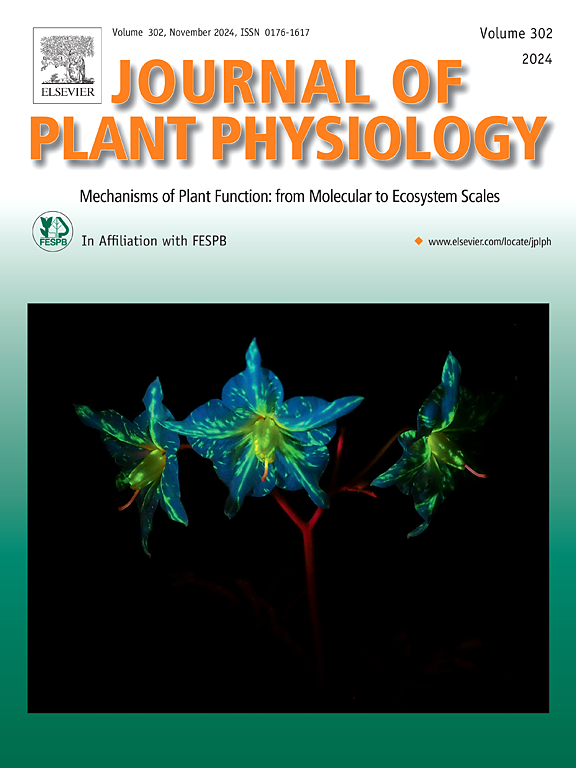A triplicated wheat-rye chromosome segment including several 12-OXOPHYTODIENOATE REDUCTASE III genes influences magnesium partitioning and impacts wheat performance at low magnesium supply
IF 4
3区 生物学
Q1 PLANT SCIENCES
引用次数: 0
Abstract
We previously reported a structural rearrangement between wheat (Triticum aestivum) and rye (Secale cereale) chromosomes 1BS/1RS that increased the dosage of 12-OXOPHYTODIENOATE REDUCTASE III (OPRIII) genes involved in jasmonate biosynthesis (henceforth, 1RW line), and that drastically reduced primary root growth relative to a control line with the intact 1RS chromosome (henceforth, 1RS). In this study, we show that the increased gene-dosage of this region is associated with increases in the shoot-root partitioning of magnesium (Mg). Moreover, both a CRISPR-edited 1RW line with reduced OPRIII dosage and the 1RW line treated with the jasmonate biosynthesis inhibitor ibuprofen showed reduced differences in shoot-root Mg partitioning than 1RW. The observed differences in Mg partitioning between 1RS and 1RW plants occur over a wide range of external Mg supplies and imply opposite trends of Mg accumulation in roots and shoots. Furthermore, we show an association between the increase of shoot-root Mg partitioning and increased tolerance of the 1RW line to low levels of Mg supply. In summary, our results provide evidence of the role of the jasmonate pathway on the dynamics of Mg accumulation in roots and shoots, which correlates with the performance of wheat plants under conditions of Mg scarcity.
包括多个 12-OXOPHYTODIENOATE REDUCTASE III 基因在内的小麦-黑麦三重染色体片段会影响镁的分配,并影响小麦在低镁供应条件下的表现。
我们以前曾报道过小麦(Triticum aestivum)和黑麦(Secale cereale)染色体 1BS/1RS 之间的结构重排,这种重排增加了参与茉莉酸盐生物合成的 12-OXOPHYTODIENOATE REDUCTASE III(OPRIII)基因的用量(以下简称 1RW 株系),并且与具有完整 1RS 染色体的对照株系(以下简称 1RS)相比,大大降低了主根的生长。在本研究中,我们发现该区域基因剂量的增加与镁(Mg)的芽-根分配增加有关。此外,与 1RW 相比,经 CRISPR 编辑的、OPRIII 剂量减少的 1RW 株系和用茉莉酸生物合成抑制剂布洛芬处理的 1RW 株系在镁分配方面的差异都有所减少。观察到的 1RS 和 1RW 植物之间的镁分配差异出现在很宽的外部镁供应范围内,这意味着镁在根部和芽中的积累趋势相反。此外,我们还发现,芽-根镁分配的增加与 1RW 品系对低水平镁供应的耐受性增强有关。总之,我们的研究结果证明了茉莉酸盐途径对根系和芽中镁积累动态的作用,这与小麦植株在镁缺乏条件下的表现相关。
本文章由计算机程序翻译,如有差异,请以英文原文为准。
求助全文
约1分钟内获得全文
求助全文
来源期刊

Journal of plant physiology
生物-植物科学
CiteScore
7.20
自引率
4.70%
发文量
196
审稿时长
32 days
期刊介绍:
The Journal of Plant Physiology is a broad-spectrum journal that welcomes high-quality submissions in all major areas of plant physiology, including plant biochemistry, functional biotechnology, computational and synthetic plant biology, growth and development, photosynthesis and respiration, transport and translocation, plant-microbe interactions, biotic and abiotic stress. Studies are welcome at all levels of integration ranging from molecules and cells to organisms and their environments and are expected to use state-of-the-art methodologies. Pure gene expression studies are not within the focus of our journal. To be considered for publication, papers must significantly contribute to the mechanistic understanding of physiological processes, and not be merely descriptive, or confirmatory of previous results. We encourage the submission of papers that explore the physiology of non-model as well as accepted model species and those that bridge basic and applied research. For instance, studies on agricultural plants that show new physiological mechanisms to improve agricultural efficiency are welcome. Studies performed under uncontrolled situations (e.g. field conditions) not providing mechanistic insight will not be considered for publication.
The Journal of Plant Physiology publishes several types of articles: Original Research Articles, Reviews, Perspectives Articles, and Short Communications. Reviews and Perspectives will be solicited by the Editors; unsolicited reviews are also welcome but only from authors with a strong track record in the field of the review. Original research papers comprise the majority of published contributions.
 求助内容:
求助内容: 应助结果提醒方式:
应助结果提醒方式:


